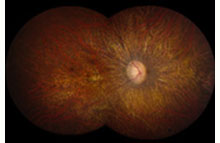Home » Clinical Trials of Gene Therapy for Leber Congenital Amaurosis » RPE65/LCA Timeline
Gene Therapy for Leber Congenital Amaurosis
RPE65/LCA Timeline
 Retina photo of a patient with Leber congenital amaurosis, an inherited retinal disease that causes severe visual impairment early in childhood. Special gene testing is necessary to determine if the patient has the RPE65-associated type of the disease.
Retina photo of a patient with Leber congenital amaurosis, an inherited retinal disease that causes severe visual impairment early in childhood. Special gene testing is necessary to determine if the patient has the RPE65-associated type of the disease.
1869
Dr. Theodor Leber (1840-1917), German ophthalmologist, first describes what is now known as Leber congenital amaurosis, an inherited retinal disease that causes severe visual impairment early in childhood
1932-34
George Wald, Ph.D. first identified vitamin A in the retina during a National Research Council fellowship in biology
1965
Human adeno-associated virus (AAV) was discovered.
1967
Dr. George Wald, Harvard University, received The Nobel Prize in Physiology or Medicine for his discovery of the role of vitamin A in the visual process
1984
Drs. Nicolas Muzyczka and Paul Hermonat, University of Florida, published an article demonstrating that adeno-associated virus (AAV) can be used to introduce foreign DNA into human and murine tissue culture cells.
1993
Dr. T. Michael Redmond of the NEI's Laboratory of Retinal Cell and Molecular Biology, Section on Gene Regulation cloned RPE65, a protein necessary for processing vitamin A in the visual cycle
1997
RPE65 gene mutations identified as the cause of congenital blindness in some children with Leber congenital amaurosis
1998
The knockout mouse model was created by Dr. T. Michael Redmond's team in the NEI's Laboratory of Retinal Cell and Molecular Biology, Section on Gene Regulation and established RPE65's role in vitamin A metabolism
1998
RPE65 gene mutation was discovered as causing congenital blindness in Briard dogs
2001
NEI-supported researchers at the University of Pennsylvania and University of Florida restore vision in a Briard dog using gene transfer RPE65 therapy
2001
NEI/NIH expands support for pre-clinical studies of RPE65 gene therapy development
2005
Restored vision in Briard dog persists longer than four years following RPE65 gene transfer
2007
NEI-supported RPE65 human clinical trial began (open label, single dose, dose escalation study) to assess the safety of using a modified adeno-associated viral vector (rAAV2-hRPE65) to deliver the normal RPE65 gene to the retina
- Principal Investigator: Dr. Sam Jacobson, University of Pennsylvania
- Principal Investigator: Dr. Barry Byrne, University of Florida
- Gene Vector Specialist: Dr. William Hauswirth, University of Florida
- Surgeon: Dr. Shalesh Kaushal, University of Florida
2008
In September, results from the NEI-supported RPE65 human clinical trial published in Human Gene Therapy and Proceedings of the National Academy of Sciences USA.
There were no vector-related serious adverse events or systemic toxicities detected in the three patient who were treated. Visual acuity was not statistically different from baseline. All patients self-reported increased visual sensitivity in the study eye compared to their control eye, especially noticeable in dim light.